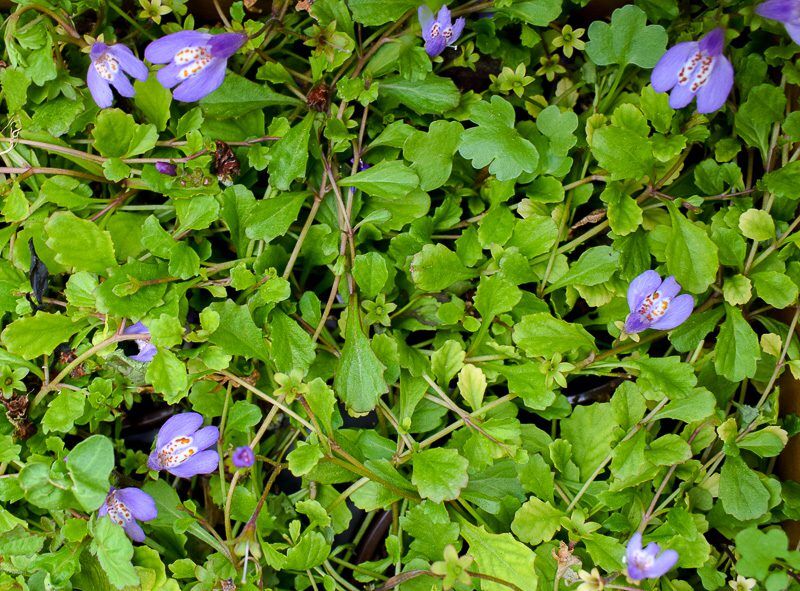ABOUT THIS PLANT
Blue Creeping Mazus
Mazus reptans
Tiny but abundant blue flowers provide perfect groundcover along moist soil or tucked between rocks.
| Flower | Blue |
|---|---|
| Bloom Time | Spring, Summer |
| Foliage | Green, Lance-shaped |
| Hardiness Zone | 4 |
| Height | 2 Inches |
| Exposure | Full Sun to Part Shade |
| Where to Plant | Moist Soil or Shallow Streams (Up to 1 Inch Deep) |
| Aggressive Grower? | No |
| Growth Rate | Fast |
| Pond Size | Any |
How to Care for Blue Creeping Mazus
- Blue Creeping Mazus Basics
- Native Area
- Planting
- In-season Care
- Winter Care
- Plants to Pair with Blue Creeping Mazus
Blue Creeping Mazus Basics
Groundcovers are a must-have for softening the edges of manmade ponds and waterfalls. And Blue Creeping Mazus, with its dense carpet of foliage and petite blue flowers, works well in just about any water feature.
Blue Creeping Mazus has purplish-blue flowers with orange-speckled white centers. These little blooms speckle the plant in early summer. Mazus’s lance-shaped serrated leaves stay green year-round in some climates.
The plant has creeping stems that root into the ground as they grow, quickly carpeting pond edges and creating a perfect groundcover.
Creeping Mazus also comes in a variety with white flowers.
Native Area
Blue Creeping Mazus is native to the Himalayas region of Asia.
Planting
Blue Creeping Mazus prefers moist soil or shallow streams up to 1 inch deep. It’s perfect for tucking between rocks in your pond or waterfall.
These plants perform best in full sun to part shade.
We recommend removing Blue Creeping Mazus from its pot and planting directly into your stream. It’s also a great choice for softening the edges of a floating island.
Planting Your Blue Creeping Mazus
Planting Blue Creeping Mazus directly into the stream not only takes away the burden of an unsightly pot but also gives your plant the ability to pull nutrients out of the water. This natural filtration helps prevent string algae and keeps your fish happy and healthy.
To plant your Blue Creeping Mazus, remove the plant from the pot. You can do this by carefully dumping out the contents or cutting the pot away with a soil knife. Then gently press the soil and roots between the rocks in your stream and cover with enough rocks and gravel to keep it in place. That’s it!
Planting in a Floating Island
Floating islands are a great choice for adding marginal plants to parts of your pond that are otherwise too deep for anything but waterlilies. They also give you a chance to get creative with your planting displays as you play around with different types and arrangements of plants in your island.
Floating islands include two pieces: a break-resistant plastic pot with drainage holes and a black fish-safe foam inner tube. The pot simply sits inside the floating inner tube.
Groundcovers like Blue Creeping Mazus make great additions to the edges of floating islands, where they can spill over the sides and camouflage the black inner tube underneath.
Check out our Floating Island Planting Guide for more tips.
Dealing with Dirt
Regardless of how you choose to display your plant, you might see a little bit of soil make its way into your pond. This is normal and will clear up on its own if you have a skimmer.
If you like to keep your pond spotless and don’t want to wait for the dirt to settle, place a Fine Filter Pad (available at Splash) in your skimmer to catch the extra tiny particles of dirt. Simply place the pad anywhere in the skimmer where the water will pass through, then remove the pad as soon as the water is clear.
Add a flocculant like Rapid Clear for even faster results.
In-Season Care
Marginal plants are easy to care for year-round.
Most marginals don’t need additional fertilizer if they’re planted directly in a pond or stream. They get all the nutrients they need right from the water. If your plant is still in a pot, however, you’ll want to use a once-a-year aquatic plant fertilizer.
Remove dead leaves and flowers from your plant throughout the season. Regular maintenance will help it channel its energy into healthy growth.
Blue Creeping Mazus grows quickly but is unlikely to take over a pond when properly tended. If your plant does seem to outgrow its spot, simply pull it out of the pond or pot, and divide it as needed.
Winter Care
Blue Creeping Mazus is winter hardy to Zone 4, meaning it will survive the winter in much of the U.S. (Check the USDA’s Plant Hardiness Zone Map if you’re not sure which zone you live in.)
Plants to Pair with Blue Creeping Mazus
The gallery was not found!Each type of plant you add to your pond pulls a different kind of nutrient out of the water. A yellow flower takes out different nutrients than a red one, and a wide leaf takes out different nutrients than a narrow one.
These nutrients will go on to feed string algae if left to grow unchecked, so the more and the wider variety of plants you have in your pond, the better.
Choose plants with a variety of colors, shapes, heights and bloom times. This mix will not only maximize nutrient uptake but also keep your pond looking beautiful throughout the season.
Plants that pair well with Blue Creeping Mazus include Variegated Society Garlic, Mini Horsetail and Marsh Marigold.
More Pond Plant Tips
| Flower | Blue |
|---|---|
| Bloom Time | Spring, Summer |
| Hardiness Zone | 4 |
| Height | 2 Inches |
| Exposure | Full Sun to Part Shade |
| Where to Plant | Moist Soil or Shallow Water (Up to 1 Inch Deep) |
| Pot Size | 4-5" |
